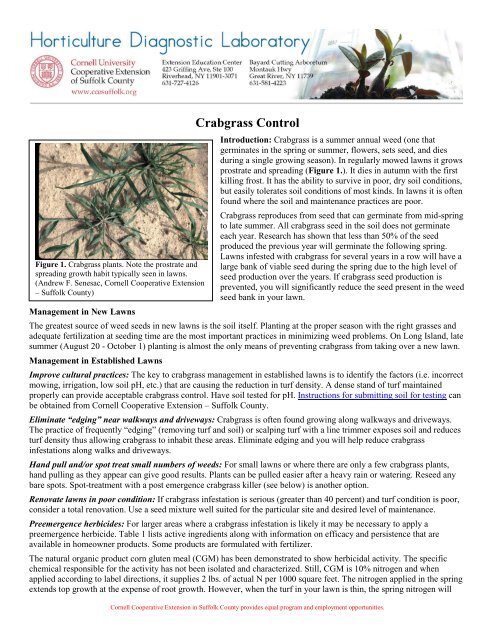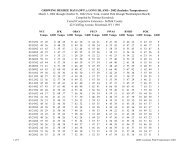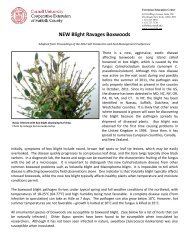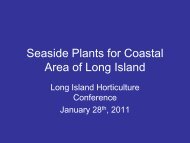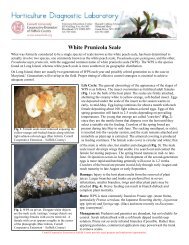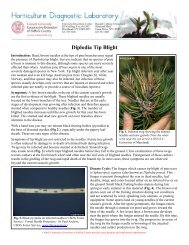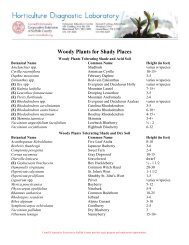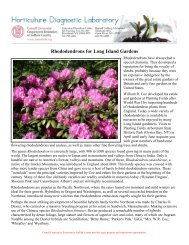Crabgrass Control - Cornell Cooperative Extension of Suffolk County
Crabgrass Control - Cornell Cooperative Extension of Suffolk County
Crabgrass Control - Cornell Cooperative Extension of Suffolk County
You also want an ePaper? Increase the reach of your titles
YUMPU automatically turns print PDFs into web optimized ePapers that Google loves.
Figure 1. <strong>Crabgrass</strong> plants. Note the prostrate and<br />
spreading growth habit typically seen in lawns.<br />
(Andrew F. Senesac, <strong>Cornell</strong> <strong>Cooperative</strong> <strong>Extension</strong><br />
– <strong>Suffolk</strong> <strong>County</strong>)<br />
Management in New Lawns<br />
<strong>Crabgrass</strong> <strong>Control</strong><br />
Introduction: <strong>Crabgrass</strong> is a summer annual weed (one that<br />
germinates in the spring or summer, flowers, sets seed, and dies<br />
during a single growing season). In regularly mowed lawns it grows<br />
prostrate and spreading (Figure 1.). It dies in autumn with the first<br />
killing frost. It has the ability to survive in poor, dry soil conditions,<br />
but easily tolerates soil conditions <strong>of</strong> most kinds. In lawns it is <strong>of</strong>ten<br />
found where the soil and maintenance practices are poor.<br />
<strong>Crabgrass</strong> reproduces from seed that can germinate from mid-spring<br />
to late summer. All crabgrass seed in the soil does not germinate<br />
each year. Research has shown that less than 50% <strong>of</strong> the seed<br />
produced the previous year will germinate the following spring.<br />
Lawns infested with crabgrass for several years in a row will have a<br />
large bank <strong>of</strong> viable seed during the spring due to the high level <strong>of</strong><br />
seed production over the years. If crabgrass seed production is<br />
prevented, you will significantly reduce the seed present in the weed<br />
seed bank in your lawn.<br />
The greatest source <strong>of</strong> weed seeds in new lawns is the soil itself. Planting at the proper season with the right grasses and<br />
adequate fertilization at seeding time are the most important practices in minimizing weed problems. On Long Island, late<br />
summer (August 20 - October 1) planting is almost the only means <strong>of</strong> preventing crabgrass from taking over a new lawn.<br />
Management in Established Lawns<br />
Improve cultural practices: The key to crabgrass management in established lawns is to identify the factors (i.e. incorrect<br />
mowing, irrigation, low soil pH, etc.) that are causing the reduction in turf density. A dense stand <strong>of</strong> turf maintained<br />
properly can provide acceptable crabgrass control. Have soil tested for pH. Instructions for submitting soil for testing can<br />
be obtained from <strong>Cornell</strong> <strong>Cooperative</strong> <strong>Extension</strong> – <strong>Suffolk</strong> <strong>County</strong>.<br />
Eliminate “edging” near walkways and driveways: <strong>Crabgrass</strong> is <strong>of</strong>ten found growing along walkways and driveways.<br />
The practice <strong>of</strong> frequently “edging” (removing turf and soil) or scalping turf with a line trimmer exposes soil and reduces<br />
turf density thus allowing crabgrass to inhabit these areas. Eliminate edging and you will help reduce crabgrass<br />
infestations along walks and driveways.<br />
Hand pull and/or spot treat small numbers <strong>of</strong> weeds: For small lawns or where there are only a few crabgrass plants,<br />
hand pulling as they appear can give good results. Plants can be pulled easier after a heavy rain or watering. Reseed any<br />
bare spots. Spot-treatment with a post emergence crabgrass killer (see below) is another option.<br />
Renovate lawns in poor condition: If crabgrass infestation is serious (greater than 40 percent) and turf condition is poor,<br />
consider a total renovation. Use a seed mixture well suited for the particular site and desired level <strong>of</strong> maintenance.<br />
Preemergence herbicides: For larger areas where a crabgrass infestation is likely it may be necessary to apply a<br />
preemergence herbicide. Table 1 lists active ingredients along with information on efficacy and persistence that are<br />
available in homeowner products. Some products are formulated with fertilizer.<br />
The natural organic product corn gluten meal (CGM) has been demonstrated to show herbicidal activity. The specific<br />
chemical responsible for the activity has not been isolated and characterized. Still, CGM is 10% nitrogen and when<br />
applied according to label directions, it supplies 2 lbs. <strong>of</strong> actual N per 1000 square feet. The nitrogen applied in the spring<br />
extends top growth at the expense <strong>of</strong> root growth. However, when the turf in your lawn is thin, the spring nitrogen will<br />
<strong>Cornell</strong> <strong>Cooperative</strong> <strong>Extension</strong> in <strong>Suffolk</strong> <strong>County</strong> provides equal program and employment opportunities.
increase density that might provide some weed control. Studies conducted by <strong>Cornell</strong> Turf Team Members Andy Senesac,<br />
Ph.D (<strong>Cornell</strong> <strong>Cooperative</strong> <strong>Extension</strong> – <strong>Suffolk</strong> <strong>County</strong> Weed Scientist) and Frank Rossi (<strong>Cornell</strong> Department <strong>of</strong><br />
Horticulture) found that season-long control (<strong>of</strong> crabgrass) with CGM does not exceed 60%. In addition, control from the<br />
CGM is not significantly different from the application <strong>of</strong> synthetic fertilizers, or in some cases, from organic fertilizers.<br />
The studies have demonstrated a substantial increase in turfgrass density in response to the nitrogen from the various<br />
sources that likely has an influence on crabgrass invasion.<br />
Preemergence herbicides do not affect un-germinated (dormant) crabgrass seeds. Instead seedling plants growing in the<br />
herbicide treated soil are unable to survive. The duration <strong>of</strong> the preemergence herbicide activity in the soil is affected by<br />
environmental conditions such as moisture, temperature, light, and the amount <strong>of</strong> organic matter in the soil. Warm, moist<br />
soils encourage microbial degradation <strong>of</strong> the herbicides carbon structure; the microbes use it as a food source. This is why<br />
in years <strong>of</strong> early and extended soil warming, preemergence herbicides fail to provide season-long control. Simply, the<br />
crabgrass germination period exceeds the residual activity <strong>of</strong> the herbicide.<br />
Table 1. Efficacy and persistence <strong>of</strong> preemergence herbicides 1<br />
Common Name Of<br />
<strong>Crabgrass</strong> <strong>Control</strong><br />
<strong>Crabgrass</strong> <strong>Control</strong><br />
Preemergence Herbicide<br />
(4-6 weeks)<br />
(12-15 weeks)<br />
Benefin E F<br />
Dithiopyr E E<br />
Pendimethalin E E<br />
Siduron F P<br />
Benefin plus trifluralin E G<br />
1<br />
E = excellent (>85% control), G = good (75-85% control), F = fair (65-75% control), P = poor (
egistration status for pesticide use in New York State should be directed to the appropriate <strong>Cornell</strong> <strong>Cooperative</strong><br />
<strong>Extension</strong> Specialist or your regional NYSDEC <strong>of</strong>fice. Read the label before applying any pesticide.<br />
TK: 3/2010 AW:1/2012


